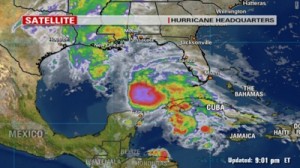I am in Baton Rouge today, working with a team representing each of the nine Small Business Development Centers to develop the disaster preparedness training in advance of the 2010 hurricane season. Forecasters expect that beginning June 1, we will see an above-average storm season, with a greater than average number of storms making landfall in the U.S., with those storms representing greater severity than historical averages. This year’s hurricane season particularly worries me because our states are facing $90 billion budget shortfalls. They simply don’t have the resources to fund a significant disaster relief effort. This was recently demonstrated to painful effect in Rhode Island. Sadly, the state with the second highest unemployment rate experienced its worst flooding in more than two centuries. This makes our preparedness efforts assume greater urgency, as with fewer resources to cushion our losses; we must redouble our efforts to mitigate the risks. On a happier note, this photograph shows one of my favorite seafood restaurants in Louisiana to which I am about to return! I can always count on being well fed when I am here.
Archive for the ‘Hurricanes’ Category
Louisiana Prepared
Thursday, April 22nd, 2010Nevis Still Reeling From 2008 Hurricane
Thursday, April 15th, 2010The government of the island of Nevis has declared the closure of the Four Seasons resort, one of the top luxury hotels in the Caribbean, a “national emergency”. The Four Seasons Nevis closed in October 2008 when it sustained severe property damage from Hurricane Omar. This week, the Sovereign Government of the Island Nation of Nevis filed a motion asking the Delaware court to abstain from hearing the Chapter 11 bankruptcy case filed by the hotel’s owner, Hotel Equity Fund V, LLC. The Nevis government argues that the bankruptcy filing could prevent the reopening of the hotel, Nevis’ largest employer. The government believes that the continued closure of the Four Seasons constitutes a national emergency for the tiny Caribbean state. Disasters can be devastating for the working poor; sadly, this is a universal phenomenon. I remember that after the terrorist attacks on the World Trade Center, three downtown hotels closed, leaving their wait staff and housekeeping staff without income. These poor souls may not be covered by unemployment insurance and almost certainly don’t have adequate savings to cushion the shock. I am making inquiries to find out if the Nevis resort carried business interruption insurance or other coverage for salary continuation or if the economic hardship experienced by the staff is the result of the loss of tip income that was not indemnified by insurance. Does anyone happen to know the answer?
Forecast Calls for An Above-Average Hurricane Season
Friday, April 9th, 2010Colorado State University’s hurricane forecasting experts predict an above average Atlantic storm season for this year, calling for 15 named tropical storms, of which eight will develop into hurricanes. A storm becomes a hurricane when its sustained wind speeds exceed 74 miles per hour. The CSU experts further expect that four of those eight will become major hurricanes, defined as Category 3, 4 or 5, with wind speeds of at least 111 mph. Historically, ten named storms occur in the Atlantic hurricane season of which six develop into hurricanes, with two major hurricanes. The CSU hurricane forecasts are known for their conservatism, as historically they have tended to underestimate the number of storms more often not. Another forecasting group, AccuWeather, expects an even more severe hurricane season with 16 – 18 tropical storms forming in the Atlantic, leading to seven storms making landfall in the U.S. The U.S. government’s National Oceanographic and Atmospheric Administration releases its forecast closer to the June 1 start date of the hurricane season. The first three named storms of 2010 will be Alex, Bonnie and Colin. With government budgets exhausted, small businesses in the path of Atlantic storms should expect even less in the way of disaster preparedness and recovery support. Begin making preparations now to protect your business. Develop a budget to set aside $1,000 or so over the next two months for an evacuation fund. Should it not prove necessary, you can release the funds after November 30, when the hurricane season ends, for other purposes.
Stress in the Florida Insurance Market
Sunday, January 3rd, 2010State Farm Florida has entered into a consent order with its state insurance regulator that will help the company to stabilize its financial condition by reducing its exposure to catastrophes and raising premiums. The Florida property insurance market is under enormous pressure; 102 of the 210 private property insurers operating in the state are losing money. Three went out of business in the last year. The consent order allows State Farm to non-renew no more than 125,000 of its 810,416 residential property insurance policies in Florida. Those policyholders designated for non-renewal will have at least six months’ notice and will be offered other insurance options. The new rates will go into effect as the remaining policies are renewed. State Farm Florida will remain the largest private insurer of property in the state and was granted a 14.8% rate increase on all homeowners’ policies. Policyholders need not take action at this time, but those of us who have looked at the declining property market in Florida need to take into consideration the rising costs of homeownership there.
Experts Forecast an Above-Average 2010 Hurricane Season
Monday, December 14th, 2009Hurricane forecasters with Colorado State University’s Tropical Meteorology Project forecast an above-average Atlantic storm season for 2010. They anticipate 11 to 16 named storms, of which 6 to 8 to become hurricanes, with 3 to 5 to strengthen to major hurricanes (Categories 3, 4 and 5 in severity) reaching sustained winds of 111 miles per hour or more. The hurricane season begins on June 1 and runs through November 30, with peak exposures in the months of August and September. The Colorado State University team assigns a two-thirds probability of at least one major hurricane to make landfall, striking the U.S. coastline in 2010. For the U.S. East Coast, the probability of a major hurricane making landfall is 40%. The team derives its forecasts from meteorological data and revises it as conditions warrant. Neverthless, the message for small businesses is clear: while we thankfully escaped a major storm in the U.S. this year, we cannot become complacent.
Ida Prompts Emergency Declaration Along the Gulf Coast
Sunday, November 8th, 2009Louisiana Governor Bobby Jindal declared a state of emergency as Hurricane Ida moved into the southern Gulf of Mexico. A hurricane warning is in effect from Pascagoula, Mississippi to Indian Pass, Florida. This area now includes New Orleans, which had earlier been excluded from the watch, and Lake Pontchartain. As of the time posting of this blog, Ida had maximum sustained winds near 105 mph with higher gusts, but is expected to weaken tomorrow and possibly begin losing tropical characteristics on Tuesday, according to the hurricane center. Ida is expected to be near coastal areas of the northern Gulf by Monday night or early Tuesday. It is expected that the combination of wind shear, cooler water temperatures and the interaction with a strong frontal system pushing off the Gulf Coast will weaken Ida’s force, but that Ida will nevertheless remain hurricane strength. In Alabama, Baldwin County officials declared a local state iof emergency and urged residents living in coastal communities or low-lying, flood-prone areas to voluntarily evacuate. Florida’s Division of Emergency Management asked residents to have disaster plans in place, as the State’s Gulf Coast has the potential to see several inches of rain, strong winds, isolated tornadoes and dangerous surf and coastal flooding beginning Monday evening and continuing into Wednesday. Thankfully, the Atlantic hurricane season ends November 30.
Mildest Hurricane Season Since 1982
Monday, October 26th, 2009Since June 1, the official start of the Atlantic storm season, only two hurricanes have formed, making this the mildest hurricane season since 1982, which also saw only two hurricanes. This year, eight tropical storms strengthened to be named storms, the lower number since 1997, but only one storm, Claudette, made landfall in the U.S. Claudette formed in the Gulf of Mexico and struck the Florida panhandle on August 16 and 17. No hurricanes made landfall in the U.S. this season to date. Still, the National Hurricane Center in Miami advises us not to become complacent as the hurricane season does not officially end until November 30. Nevertheless, the peak hurricane season occurs from late August until mid-October, so the worst may be behind us for 2009. The U.S. may have benefited from the “El Niño” climate phenomenon in which warmer waters in the Pacific Ocean produce weather patterns that create wind shear in the Atlantic Ocean. The wind shears, strong winds blowing from different directions at different altitudes, can tear apart tropical waves emerging from the African coast that can develop into hurricanes.
The respite is surely welcome in the Gulf Coast states, which are still recovering from a very active hurricane season in 2005, when the National Hurricane Center ran through the alphabet in naming 28 tropical storms. A spokeswoman for the Property Casualty Insurers Association of America stated that insurers will use 2009 to rebuild their claims reserves after paying out more than $90 billion over the past decade in connection with hurricane losses. The break is particularly welcome for small businesses that would have difficulty budgeting for hurricane-related evacuations in this difficult economy. However, we should also remember that while hurricanes provide graphic imagery on television, it was a tornado that killed 21 people in Central Florida on February 2, 2007. As always, we must be ready for the everyday disaster to build resilience for the more serious ones.
Experts Dial Down Hurricane Forecasts
Wednesday, August 5th, 2009The forecasting team at Colorado State University revised its forecast for the 2009 Atlantic storm season, reducing the number of predicted hurricanes from eleven to four. Based on El Niño events early in the season (the season begins on June 1, but historically, the date of the first hurricane is typically August 14), the storm season is likely to be calmer than originally thought. El Niño is the phenomenon of Pacific Ocean warming that affects global weather patterns. It tends to correlate with increased vertical wind shear that weakens tropical storms before they can form hurricanes. The forecast now calls for ten named tropical storms, with four likely to become hurricanes and two of the four expected to become major hurricanes (meaning wind speeds of 111 mph or more). This is welcome news at any time, but particularly in this difficult economy, with fewer financial resources available to support disaster relief efforts.
FEMA Housing Proposals Should Motivate You
Sunday, June 7th, 2009It started with a plan for transition to those displaced by Hurricane Katrina. It ended with a proposal for temporary housing for disaster victims that should motivate people to put their own plans in place. The federal government plans to donate approximately 1,800 mobile homes to 3,400 families living in those homes since they were displaced by Katrina. The government also plans to distribute $50 million in rental vouchers to low-income trailer residents to move into targeted housing projects and will assume from the State of Louisiana the responsibility of helping those people secure permanent housing. Excess trailer homes from FEMA’s inventory (the Federal Emergency Management Agency) will be donated to state and local governments and nonprofit groups.
These actions are motivated by a desire to provide a more humane transition to more vulnerable populations that were facing FEMA’s threatened eviction action after the trailer program ended on May 1, 2009. FEMA’s housing assistance program typically provides support for 18 months. In the case of Hurricane Katrina, FEMA extended assistance for 45 months. Since many local jurisdictions in the Gulf Coast will not change their zoning ordinances to allow trailer homes, this initiative may be of limited benefit.
Meanwhile, FEMA officials told the Associated Press that they are evaluating options to house Florida hurricane evacuees in foreclosed homes should a severe storm exhaust the availability of all other housing options. This proposal is motivated by concern to stabilize disaster-affected communities rather than having evacuees disperse across the country and possibly not return, which was the experience of Louisiana in the aftermath of Katrina. Given the legal issues involved in determining ownership and rights to a foreclosed property and the uncertainty around the condition of the properties, this seems an unattractive option. Foreclosed homes are generally not maintained and lacking basic utilities. Residents of hurricane-exposed communities should begin to put their own plans in place.
Pop-Up Storms Change Our Timeframe
Tuesday, June 2nd, 2009So-called “pop-up storms” are a new phenomenon confounding hurricane forecasting. Typically during the Atlantic storm season, hurricanes would form off of the coast of Africa and travel westward towards the United States, providing ample notice of impending landfall. But meteorologists are noting a new trend, possibly beginning with Hurricane Umberto in 2007, in which storms “pop up” off the coast of the United States and make landfall very rapidly. This means that residents of affected areas have less notice to prepare evacuations. Of course, you should have your small business prepared to evacuate on short notice, as the more statistically significant risks, such as fires, do not come with early warnings as do hurricanes. Unfortunately, however, residents of hurricane-affected areas tend to distort their risk assessment based on this unique exposure. So how should the new trend of pop-up storms motivate small business preparedness? You should tighten your time frames for response to such threats. Begin with your home and office telecommunications strategy.
Here is a tip verbatim from the Prepare for the Worst, Plan for the Best: Disaster Preparedness and Recovery for Small Businesses (Wiley, second edition, 2008). Think in reverse for forwarding critical business calls. The cell phone is the natural backup solution for landlines. The question is how to automatically connect land- and cell-phone based service so that the cell phone service would take over once the landlines have failed. The problem is two-fold: once the landlines have failed, it is not possible for you to forward them to the cell phones. Moreover, in an emergency, such as an earthquake, you want to evacuate quickly and should not put yourself in harm’s way by returning to your office to deal with the phones. The solution is developed by thinking in reverse. Use the cell phone as your general business contact number. Program the phone in such a way that any incoming call is forwarded to your land-based business phone number when the cellular phone is switched off. If your land-based line fails (or you are unable to return to your office to access it), you simply switch on your cellular phone, and voilà. This is what I did on the morning of 9-11, when I evacuated the World Trade Center, but it was not safe to return to my office. I went home to shelter in place and turned on my cell phone to receive all incoming office calls. If you implement this strategy right away, you have a plan for continuous telecommunications and it is one less thing for you to worry about if you have to evacuate on short notice.





